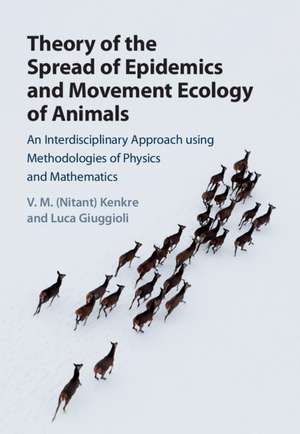Theory of the Spread of Epidemics and Movement Ecology of Animals: An Interdisciplinary Approach using Methodologies of Physics and Mathematics
Autor V. M. (Nitant) Kenkre, Luca Giuggiolien Limba Engleză Hardback – 27 ian 2021
Preț: 1001.91 lei
Preț vechi: 1165.01 lei
-14% Nou
Puncte Express: 1503
Preț estimativ în valută:
191.71€ • 200.18$ • 158.31£
191.71€ • 200.18$ • 158.31£
Carte tipărită la comandă
Livrare economică 15-29 aprilie
Preluare comenzi: 021 569.72.76
Specificații
ISBN-13: 9781108841405
ISBN-10: 1108841406
Pagini: 400
Dimensiuni: 175 x 250 x 19 mm
Greutate: 0.73 kg
Editura: Cambridge University Press
Colecția Cambridge University Press
Locul publicării:Cambridge, United Kingdom
ISBN-10: 1108841406
Pagini: 400
Dimensiuni: 175 x 250 x 19 mm
Greutate: 0.73 kg
Editura: Cambridge University Press
Colecția Cambridge University Press
Locul publicării:Cambridge, United Kingdom
Cuprins
1. Theoretical Framework Underlying the Book; 2. μ-space Approach to the Study of Epidemics: Fisher Equation with Internal States; 3. Abrupt Spatial Transitions: Patchiness and Extinction of Infection and Population; 4. Results from Fisher Variants: Patterns from Long-range Competition and Allee Effect in the Spread of Infection; 5. Extraction of Parameters from Observations, Emergence of Home Ranges, and Applicability of the Fisher Equation for Bacteria; 6. Explicit Incorporation of Home Ranges in the Theory of the Spread of Epidemics; 7. Avoidance Interactions and the Emergence of Spatial Segregation; 8. Attractive Interactions and Flocking; 9. Related Investigations along Miscellaneous Directions; 10. Summary and Future Directions; Appendix A: A Technical Appendix; Appendix B: A Historical Appendix.
Recenzii
'These authors have successfully written for adventurous interdisciplinary investigators who seek to understand how physics and biology can be combined to understand and develop effective strategies for disease containment. It would be difficult to find a more appropriate book for understanding and addressing the current pandemic … Highly recommended.' M. Schaab, Choice
Notă biografică
Descriere
Powerful analytical tools from statistical physics, guided by field observations are applied to spread of epidemics and movement ecology.
